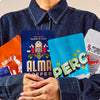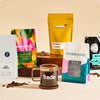We’re putting on our wetsuits and taking a deep dive into some of our favorite coffee drinks. This time out, we’re getting to know a cocktail that found a second act in 2021: the espresso martini.
What is an espresso martini?
An espresso martini is a drink traditionally made with liquor and coffee. There are hundreds of variations, but most espresso martini recipes include some or all of the following ingredients: either vodka or gin, coffee (usually espresso but this varies as well), coffee liqueur, and a sweetener. The drink was initially popular in the 1980s and early 1990s and has seen a resurgence in 2021.
Espresso martinis are usually chilled, served up, and shaken. Shaking the drink helps develop a characteristic foam on top, and some bartenders will finish the drink with whole coffee beans for garnish.
History of the espresso martini
Most articles cite Dick Bradsell as the inventor of the espresso martini. Bradsell was a London-based bartender who is credited with a handful of original cocktail inventions and for helping revitalize the cocktail scene in the 1980s. A popular myth is that, in the mid ‘80s, either Kate Moss or Naomi Campbell asked Bradsell to make “something to wake me up, then f—k me up.” Both models were children at the time, so it’s unlikely that either of them made this request, and the originator of this legendary quote will never be known.
Espresso martinis over time
Bradsell’s original espresso martini used only espresso, vodka, and simple syrup. At the time, the drink was called a Vodka Espresso, but as martinis became more mainstream (think of Appletinis and drinks being served in V-shaped martini glasses), the name shifted — for a brief period, when Bradsell designed a cocktail menu for artist Damien Hirst’s London installation, Pharmacy, he tried out the name “Pharmaceutical Stimulant.”
Now, there are hundreds of riffs on espresso martinis, but the general outline remains the same: a liquor, a coffee, and some sort of sweetener. Instead of using coffee, some recipes call for coffee liqueurs, like Kaluha. As espresso martinis became popular again, bartenders have mixed it up, sometimes using cold brew as the coffee element in the drink.
How to make an espresso martini at home
We talked to Brandon Paul Weaver, owner of Liberty Bar in Seattle, Washington and a judge for the United States Coffee in Good Spirits Competition, about how you can replicate the iconic drink at home.
“The biggest problem I see is over diluted drinks which can happen for two reasons,” he says. “With espresso, adding it directly to the cocktail can melt the ice and make everything watery. Cold brew is already mostly water so you have the same problem. I recommend shaking all your non coffee ingredients together with ice, straining that into the coffee and shaking it again without ice. It helps a lot if you chill the espresso first as well.”
Weaver says that both gin and vodka are pretty neutral pairings with coffee, but you can go off-script with an unexpected liquor as your base. “I like to mix it up and use cachaça in mine and a lot of naturally processed coffees pair really well with the Brazilian spirit,” he says. You can also play with different bitters or try an amaro, a class of Italian bitter liqueurs, that traditionally pair well with coffee. “Playing around with different amaros and bitters can give you an instant original,” he says.
There’s really no end to the variations you can try. “The other way to vary your recipe is to play with the sweetener,” Weaver suggests. “Simple syrup works great but why not use a vanilla syrup or orgeat?” You can also play with non-alcoholic spirits, using the same principles listed above.
What coffees go well with an espresso martini?
You want the coffee to stand out in the drink — it is called an espresso martini after all! How you choose to prepare your coffee will determine what profiles will make the best espresso coffee for the drink.
“I think for the cold brew option I would pick a coffee with really bold flavors like a naturally processed coffee or some classic Sumatran coffees,” says Weaver. Because cold brew isn’t as concentrated as espresso, you need something that’ll stand out and hold its own against the liquor in the drink.
If you’re going with a classic espresso base, you have a few more options. “For espresso, it's a lot easier to concentrate flavor so you can use a much wider range of coffees and still get enough flavor into your cocktail.” You can try coffees from Ethiopia or Colombia, or try to pair the coffee to your chosen spirit. As Weaver notes, he chose a naturally processed coffee to pair with cachaça — Brazil produces a lot of naturally processed coffees, so you can take a cue from what’s hanging around your liquor cabinet.
Espresso martini recipe
Weaver calls this the Bangarang Espresso Martini, using cachaça, a Brazilian liquor that can taste like Christmas spices and dried fruits, as the base spirit and choosing ingredients to support that flavor profile. Feel free to mix things up, using this recipe as a base and building flavor combinations based on your chosen spirit or coffee. Try pairing a floral Ethiopian coffee with gin, a Colombian coffee with rum (although you could definitely do gin with a Colombian coffee — especially a gesha varietal), a cold brew with whiskey, the list goes on!
Bangarang Espresso Martini
Ingredients
- A shot of espresso, preferably from a naturally-processed Brazilian bean
- 1 ounce cachaça
- 0.5 ounces Averna
- 0.5 ounces vanilla syrup
- 2 dashes each of lavender and chocolate bitters
Instructions
- After pulling your shot of espresso, flash chill it by filling a large shaker tin with water and ice and place a small tin in the water bath. Pour the espresso into the small tin
- Combine all the other ingredients in a shaker and shake with ice (no espresso yet). Strain
- Pour the espresso into the shaken drink, and shake again with no ice. This will form a foamy head at the top of the drink
- Serve in a (chilled, if you can) coupe glass and enjoy!





